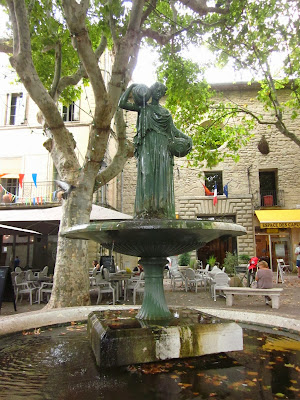I'm just back home again, after 20 days in Southwest France. Why was I there (i.e., why not Paris)? Well, the city of Toulouse was the site of the World Canals Conference in 2013. Toulouse is the link between two great canals: The Canal du Midi and the Canal Lateral de Garonne. I had cruised upon the Canal du Midi in 2009 with five other women; it connects the Mediterranean Sea westward to Toulouse. The Lateral I knew nothing about. Thus they combine to make the Canal of the Two Seas - Mediterranean Sea and Atlantic Ocean.
And because my two hiking/canalling friends and I would be in a new place, I had the brilliant idea to combine two loves of mine: hiking and Roman antiquities, specifically the Pont du Gard, which has stood strong and stunning for 2,000 years. A company called Enlightened Traveller helped us create a five-day hiking trip that would include the beautiful "water bridge" - the Pont du Gard. So here begins our hiking trip on September 7.
 |
| This wayside exhibit shows, in red, the downward route of the great aqueduct, from its source in the springs of Uzes to the Roman city at Nimes. |
Our hike was not along the route of the aqueduct. Rather it was along the gorge carved out by the Gardon River.
We made our way to the hill town of Uzes via plane to Paris, TGV to Nimes, and bus to Uzes, a very old city where the ancient Roman aqueduct originated. The original springs still flow, but no longer direct water to the aqueduct.
 |
| The original springs still flow, but are now directed into the Alzon River. |
Uzes still has several springs, in addition to those that supplied the aqueduct. Throughout the town were old public fountains, many bearing the legend "Eau Potable" - drinkable water.
This town was a good introduction to medieval France: buildings made of stone or brick, narrow little streets, and very much up and down, with towers and churches and flowers.
 |
| St Theodorit Cathedral and the Place de l'Eveche. The tower is called Tour Fenestrelle. |
 |
| A narrow little car-free street on the way to the Cathedrale where our hike began. |
Our B&B (French = chambres d'hotes), La Maison de La Bourgade, was one or two blocks from the center of town (and the bus stop). Quite a nice place, complete with a swimming pool. Of course, we headed for it very quickly. Hmm. Not heated! But, as Elisabeth, our hostess said: "It is quite refreshing". My room overlooked both the courtyard and the street.
 |
| You can see the several tables set for breakfast; the chilly pool is just barely visible in the upper right corner. |
The town's large "Place aux herbes" is ringed with cafes and shops, with plenty of open space in the center.
 |
| Quite a large open square; the arches denote the large open vaulted area, some of which served as cafes and others as shops, with a few being vacant. |
We dined there at an open-air cafe called Thierry. The Place is also the site for the weekly farmer's market, which we visited first thing on Saturday morning. Not really a true farmer's market (i.e., not producers only), there were charcuterie, poisson, viand, pain, and old clothes for sale. Quite a busy place.
 |
| clearly the domain of the fishmonger; I wish I knew the French word for fishmonger. |
 |
| the bucherie? or just a stand where meat was being sold? |
 |
| "Ail" is the French word for garlic. Imagine calling a variety of garlic "Rose du Tarn". Tarn is the name of a river many miles away. |
Between Friday evening (our arrival) and Saturday midday (our first day's walk) we investigated a bit of the town, bought postcards/stamps, and generally got acclimated. The first day's walk was about 5 miles, down the mountain fairly gradually into the gorge.
 |
| This beautiful stone wall is somewhere between "Mas Cazotte" and "Moulin de Carriere". I'd love to know if the herringbone pattern of the dry-laid stone wall contributes to its stability |
Crossing the Alzon River; passing walled homes; investigating a former mill; through a town forest;
and rewarded by a wonderful vista across the gorge to the town and its several towers.
 |
If I'd paid more attention, I could identify the towers; but I'm satisfied with a lovely view.
Then back down into the gorge to follow the path of the old aqueduct (here it was a channel just a few feet wide) |
 |
| Pat has walked through a tunnel that is a remnant of the 2,000 year old aqueduct while Barbara rests on the stone wall. |
 |
| Although the aqueduct delivered thousands of liters of drinkable water to the inhabitants of the important city of Nimes, it appears to be quite small, don't you think? |
and Northward to the source - the Fontaines d'Eure.
 |
| The large sign: "Eure spring captured by the Romans to supply Nimes drinking water through the aqueduct" |
Back at the B&B we tried the pool again - - more "refreshing" than the day before. As we walked back to the Place for dinner, rain began to fall. Very intensely falling.
 |
| No dining in the square tonight. |
We ducked into the nearest likely-looking cafe. There are several in the vaults that formed the ground floor of the surrounding buildings. It made for a very different kind of dining experience - quite nice to be warm and dry amid the trickle of puddles and the constant rainfall. And the rain tapered off enough for us to scurry back "home" and pack up for a move to the next B & B.



















No comments:
Post a Comment